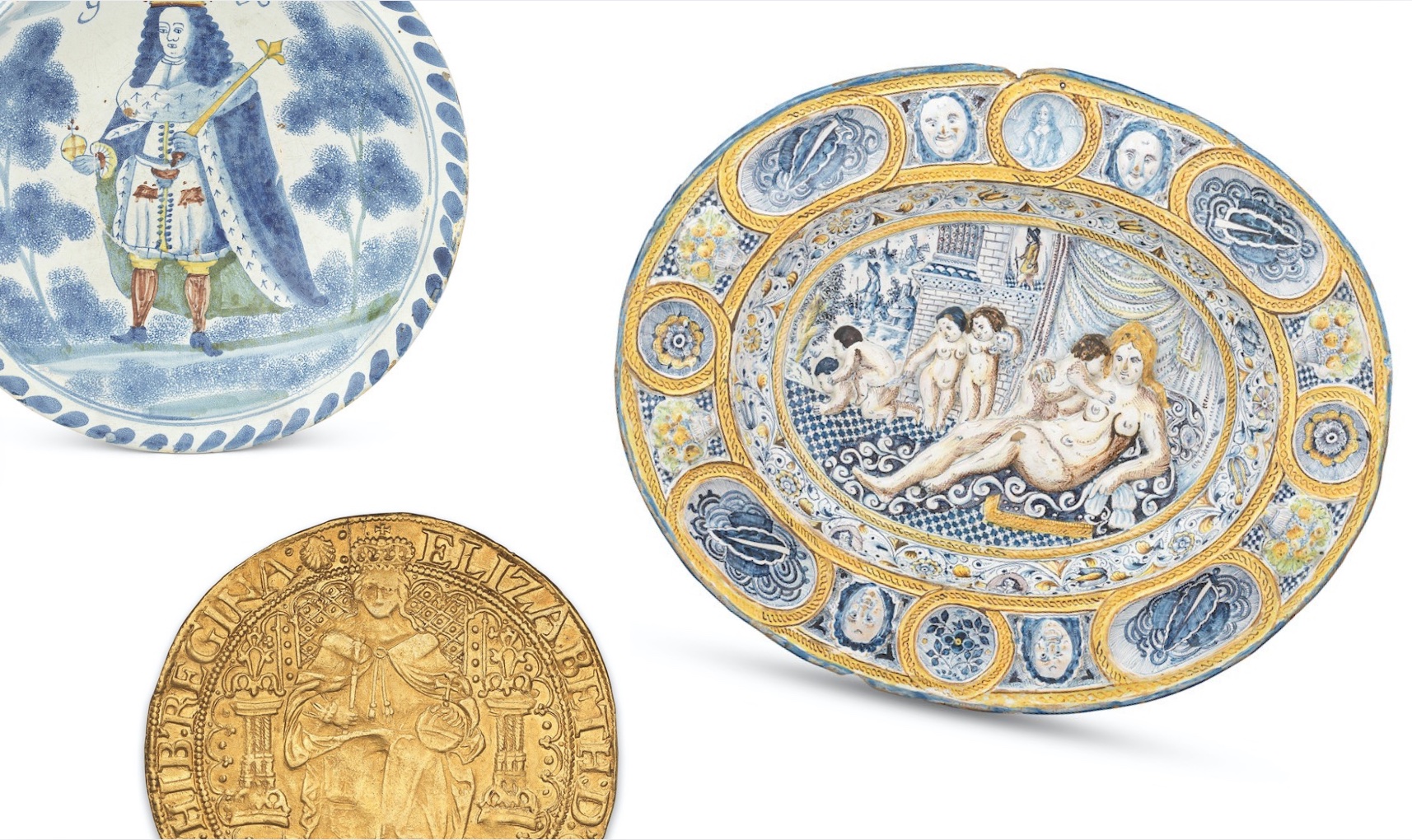
.
.
.
#ModernAntiquarian #GrahamSlaterCollection #DelftwareTreasures #ArtFundSupport #BonhamsAuction #EnglishPottery #AntiqueCollecting #HistoricCeramics #MudlarkingMemories #17thCenturyArt #ElizabethanCoins #PatrickHeronArt #MedievalJug #AntiqueHunter #CollectorsLegacy
A Modern Antiquarian: The Collection of Graham Slater
Bonhams is set to present A Modern Antiquarian: The Collection of Graham Slater in April, featuring a remarkable array of delftware, early English pottery, coins, and works of art. The sale will support Art Fund, a charity dedicated to enriching the UK’s museums and galleries. Highlights include a 17th-century London Delftware ‘La Fecundite’ dish (£30,000-50,000), a gold Elizabethan Coronation Crown (£8,000-10,000), and works by Modern British artists such as Patrick Heron, John Piper, and Edward Bawden. The sale is divided into two parts: Part I, a live auction on April 15 at Bonhams New Bond Street, and Part II, an online sale ending on April 16.
The Collector: Graham Slater (1927-2024)
Graham Slater’s lifelong passion for collecting began at the age of five, when his father gifted him foreign stamps. By seven, he was captivated by Matchbox toys, and soon ventured into collecting prints and early English books from London’s market stalls, despite the city’s devastation during the Blitz. Slater’s interests evolved over time, sparked by a stay in Malta for his health, which ignited a fascination with archaeology and geology. Later, he and his wife, Rosemary, developed a shared love for Indian sculpture, though they eventually parted with their collection to make room for their growing assemblage of English delftware.
Slater’s passion extended to late-medieval London relics, English ecclesiastical architecture, and rustic wooden objects. Together with Rosemary, he became an avid mudlarker, exploring the Thames’s banks for fragments unearthed by the tides. His expertise in English delftware earned him recognition as a leading academic authority in the field. Even in his 90s, Slater remained captivated by the thrill of discovery and the meticulous study of his collections. Highlights from his collection reflect his eclectic tastes and scholarly dedication.
Highlights of the Sale
The auction features standout pieces that showcase Slater’s discerning eye and breadth of interests:
- London Delftware ‘La Fecundite’ Dish (circa 1657-59): This rare dish, attributed to the potter ‘WP’, is estimated at £30,000-50,000.
- Patrick Heron Works: Two pieces by the acclaimed Modern British artist, FEBRUARY 8 1984 and MINI FEBRUARY I: 1974, each estimated at £10,000-15,000.
- English Medieval Anthropomorphic Jug (13th century): A striking example of early English pottery, estimated at £8,000-12,000.
- English Delftware Charger (circa 1714): Featuring a blue dash rim, this piece is estimated at £7,000-10,000.
- Elizabeth I Coin (1558-1603): A gold Coronation Crown depicting the enthroned queen, estimated at £8,000-10,000.
- Book of Hours (Use of Rome): Illuminated on vellum with full-page woodcuts, this rare manuscript is estimated at £5,000-8,000.
Supporting Art Fund
Graham Slater’s collection is not only a testament to his passion but also a generous gift to Art Fund. The sale proceeds will support the charity’s Expanding Horizons campaign, which funds professional development for museum staff across the UK, including curators, conservators, educators, and exhibition-makers. Slater’s children, Corinna and Crispin Slater, have facilitated this bequest, ensuring their father’s legacy continues to inspire and nurture future generations of art and history enthusiasts.
A Collector’s Legacy
Charlie Thomas, Bonhams’ UK Group Director for House Sales and Private & Iconic Collections, praised Slater’s devotion to collecting: “Graham was a collector in the old-fashioned sense of the word—a real scholar who surrounded himself with objects and then learned everything there was to know about them. This sale is a celebration of his remarkable legacy and a tribute to his generosity in supporting Art Fund.”
The auction of A Modern Antiquarian: The Collection of Graham Slater invites collectors and enthusiasts to explore a lifetime of passion, scholarship, and discovery. Through this sale, Slater’s enduring love for art and history will continue to enrich the cultural landscape of the UK.


